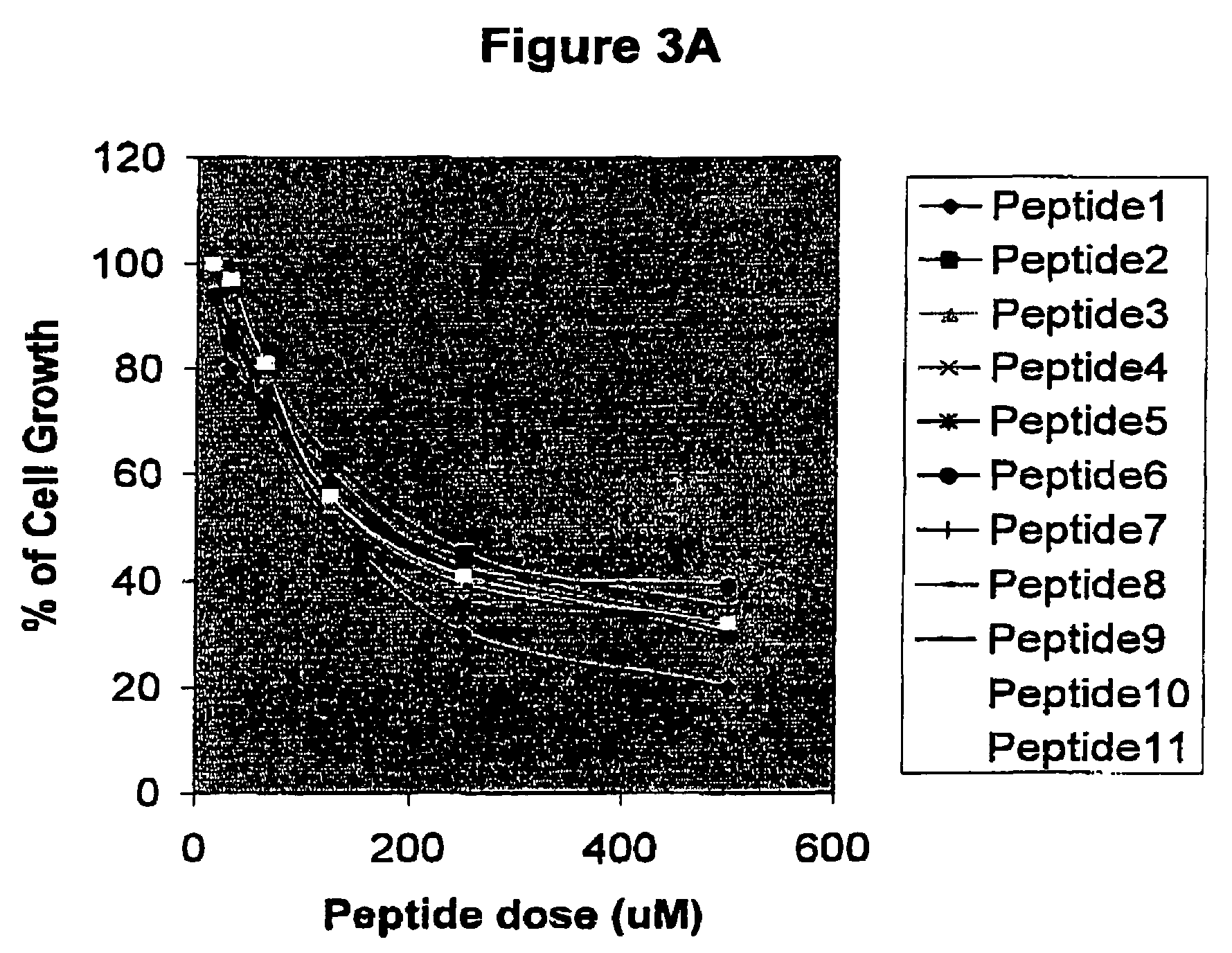Peptides for the treatment of cancer associated with the human papilloma virus (HPV) and other epithelial tumors
a technology of human papilloma virus and epithelial tumors, applied in the field of molecular pharmacology, can solve the problems of high cost and benefit risk of hpv-vaccine approach, difficult manufacturing, and difficult to meet the needs of patients, and achieve the effect of low cost and easy manufacturing
- Summary
- Abstract
- Description
- Claims
- Application Information
AI Technical Summary
Benefits of technology
Problems solved by technology
Method used
Image
Examples
example 1
Effect of the peptides on the CKII phosphorvlation site:
[0031]This assay is based on an in vitro phosphorylation reaction using the substrate sequence RRREEETEEE (SEQ ID NO: 12) which represents the optimized consensus domain for the CKII phosphorylation. The reaction is performed in 50 μl of Tris:HCL 25 mM pH 7.5, 1 μCi32P-γATP, 100 μM ATP, 2 mg / ml of the substrate peptide, 0.2 M NaCl, 10 mM MgCl and 1 unit of the CKII enzyme (Promega). Reaction is incubated at 37° C. during 10 minutes.
[0032]Afterward, 5 μl of reaction were spotted onto PE-81 chromatography paper (Whatmann) and four washes with 10 mM H3PO4 were made. Finally, the radioactivity associated to the filters was measured and the cpm levels show the CKII enzymatic activity in each sample. Simultaneously, an specific CKII inhibitor like heparin is included in the assay as an internal control. Data show in the FIG. 1 demonstrated that cyclic peptides inhibit the CKII phosphorylation by 80%. Also, lineal peptides inhibit the...
example 2
Effect of the Peptides on the HPV-16 E7 Phosphorylation
[0033]This assay is based on the in vitro phosphorylation reaction of the HPV-16 E7 oncoprotein expressed in E. Coli as a fusion protein to the Glutathione S Transferase (GST). Before enzymatic reaction, the E7-GST fusion protein was purified by affinity chromatography using Glutathione Sepharose beads (Pharmacia). The mixture reaction is performed in 50 μl de buffer Tris:HCL 25 mM pH 7.5, 1 μCi de 32P-γATP, 100 μM ATP, 40 μl of the beads containing E7-GST, 0.2 M NaCl, 10 mM MgCl and 1 unit of CKII (Promega). The reaction is incubated at 37° C. during 40 min. Afterward, the beads are washed away three times with 0.5 ml of the buffer and finally the phosphorylation level of the E7-GST is analyzed by 10% SDS-PAGE electrophoresis. The visualization of the phosphorylated proteins was performed by developing X-Rays films previously exposed to the dried gels. The quantification of the E7 phosphorylation was made by densitom try. Data ...
example 3
Effect of the Peptides on the Proliferation of HPV-16 and HPV-18-Transformed Cells (CaSki and HeLa Respectively
[0034]In this assay, CaSki or HeLa cells were seeded at 2×104 cells / ml in 96-well plates (Costar) using DMEM supplied with 10% of Fetal Calf Serum (FCS) (Gibco). After 24 hours, peptides were added to the culture medium at doses comprising a range between 15 μM and 500 μM. The incubation was performed during 96 hours in 5%CO2 and finally 20 μl of a MTS solution (1.90 mg / ml) Promega were added to each well. Plates were subsequently maintained one hour at the same incubation conditions and the absorbance at 490 nm was finally analyzed. Results are expressed as percent of growth respect the control without peptides. For this purpose, both cyclic and lineal peptides were chemically synthesized fused to the HIV-1 Tat-1 cell penetrating peptide which is able to penetrate into cytoplasm and nucleus (Schwarze S R, Dowdy S F, 2000, Trends Pharmacol 21:45-48). Data obtained from this...
PUM
| Property | Measurement | Unit |
|---|---|---|
| weight | aaaaa | aaaaa |
| weight | aaaaa | aaaaa |
| cyclic structure | aaaaa | aaaaa |
Abstract
Description
Claims
Application Information
 Login to View More
Login to View More - R&D
- Intellectual Property
- Life Sciences
- Materials
- Tech Scout
- Unparalleled Data Quality
- Higher Quality Content
- 60% Fewer Hallucinations
Browse by: Latest US Patents, China's latest patents, Technical Efficacy Thesaurus, Application Domain, Technology Topic, Popular Technical Reports.
© 2025 PatSnap. All rights reserved.Legal|Privacy policy|Modern Slavery Act Transparency Statement|Sitemap|About US| Contact US: help@patsnap.com



